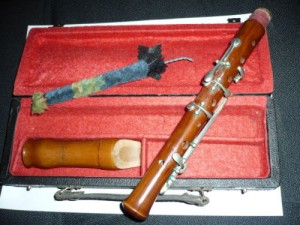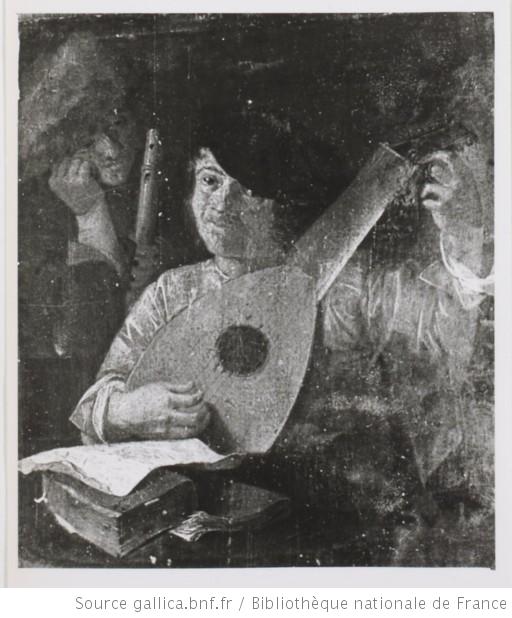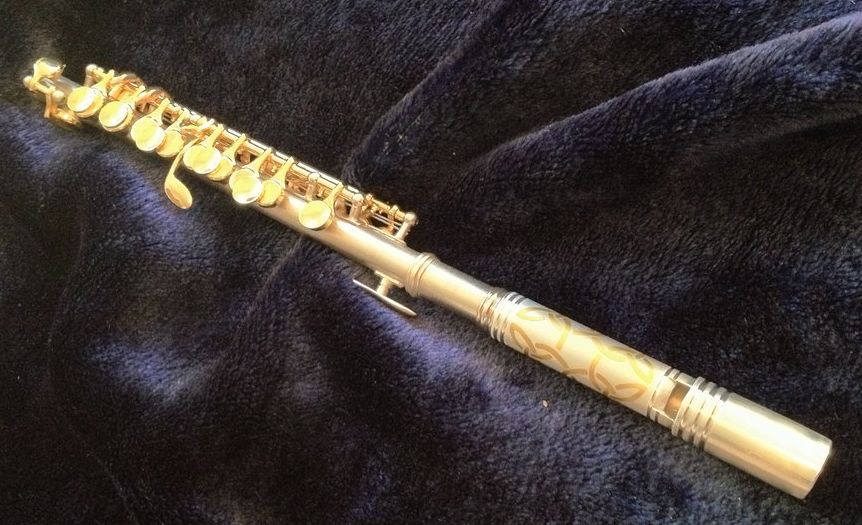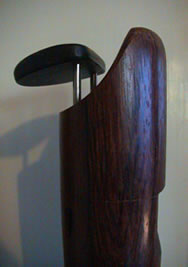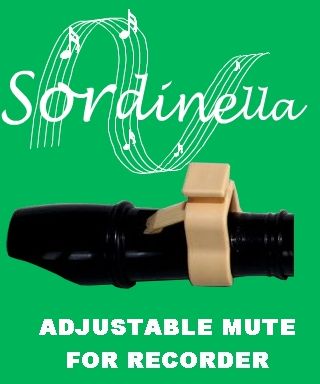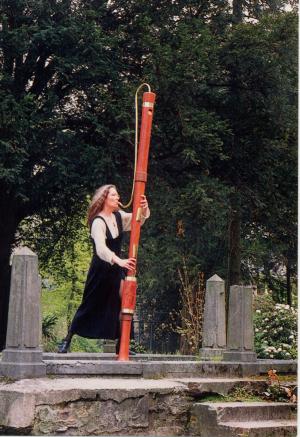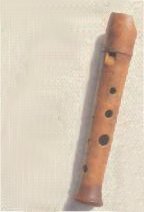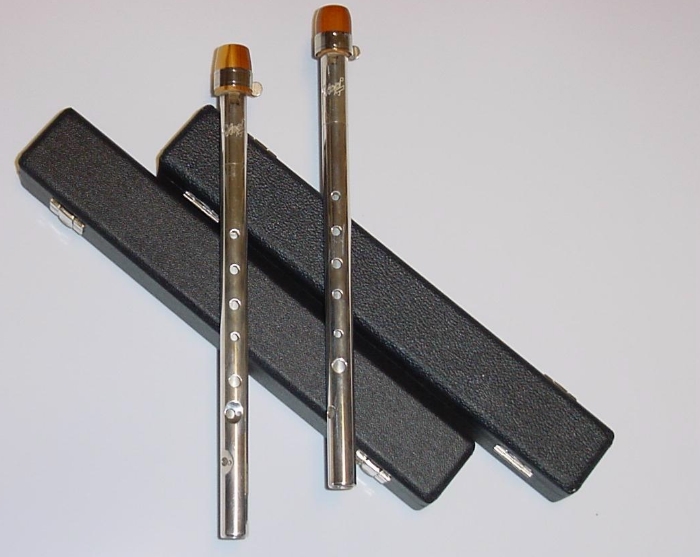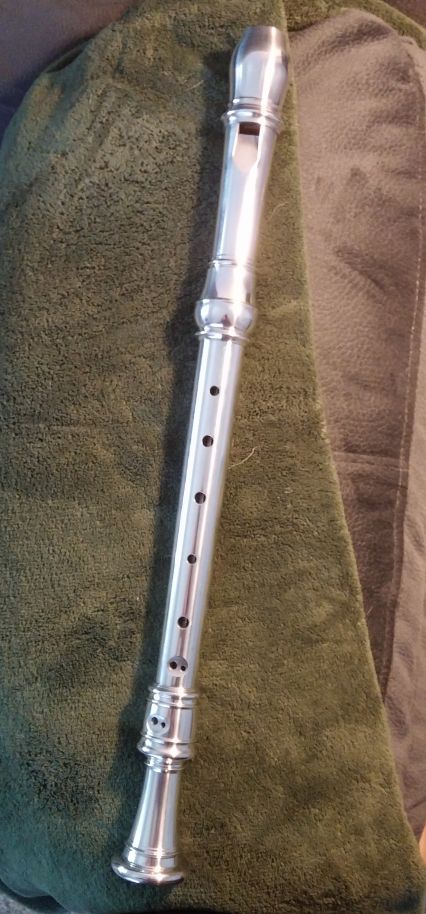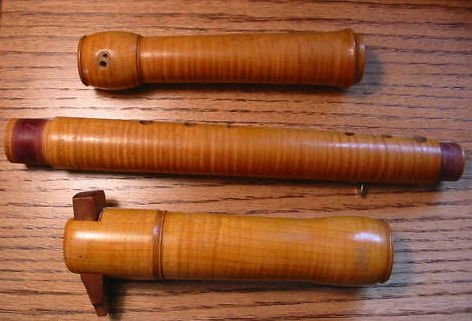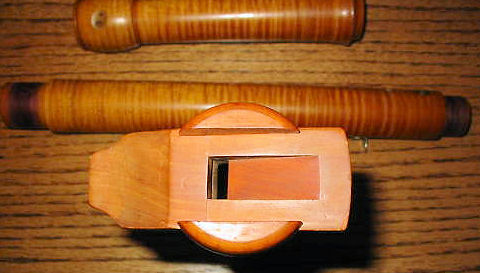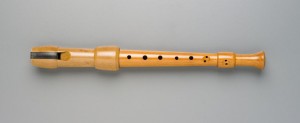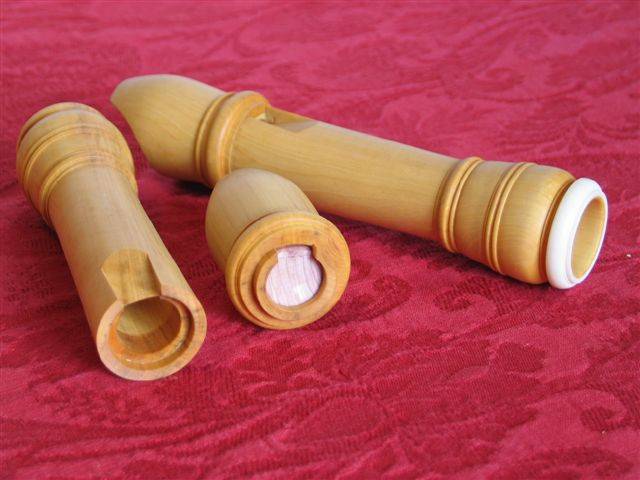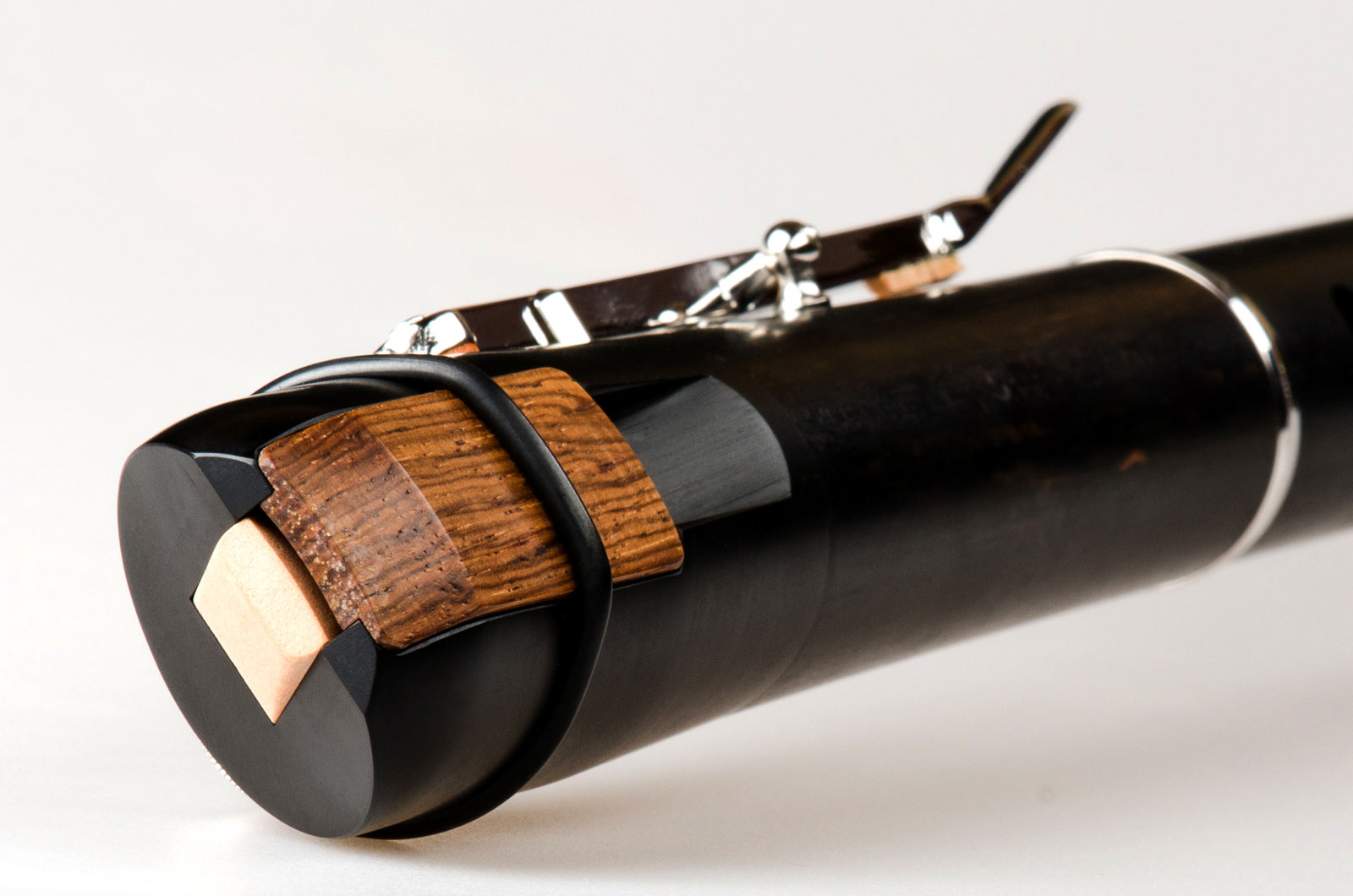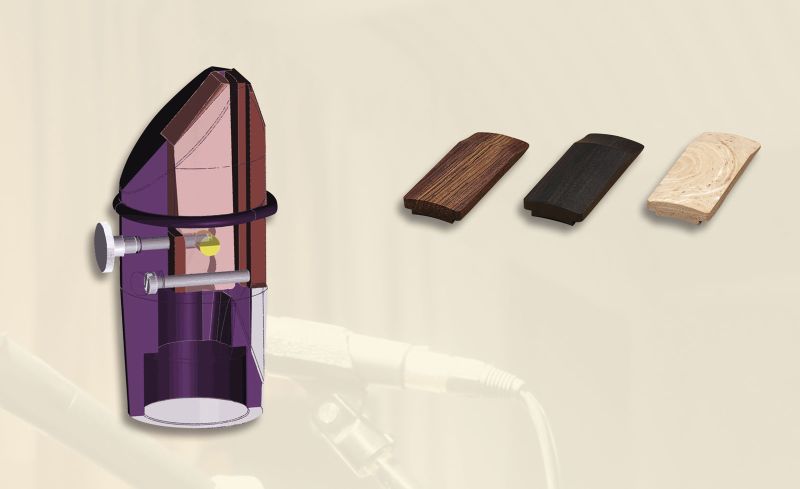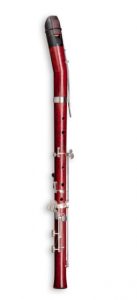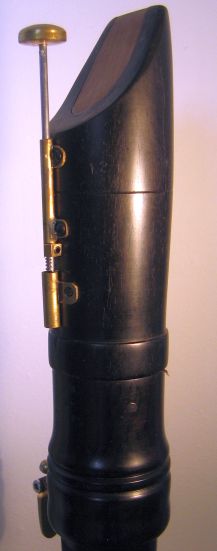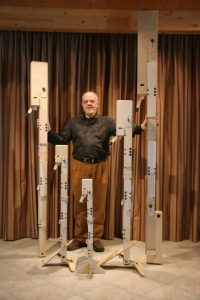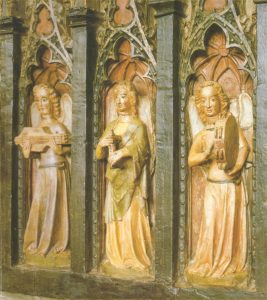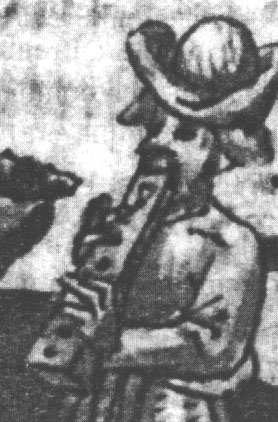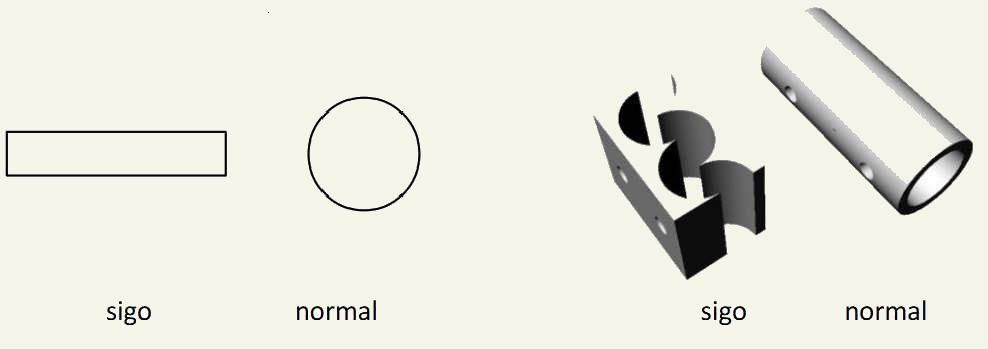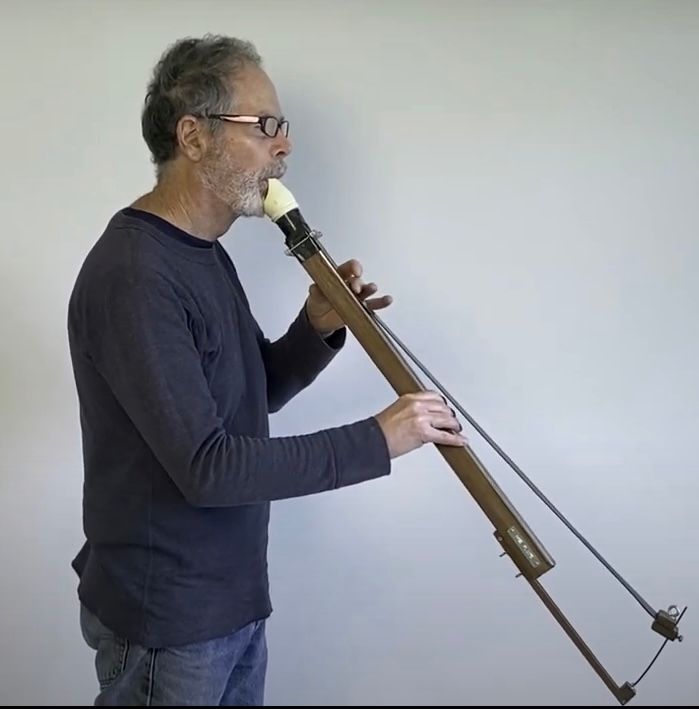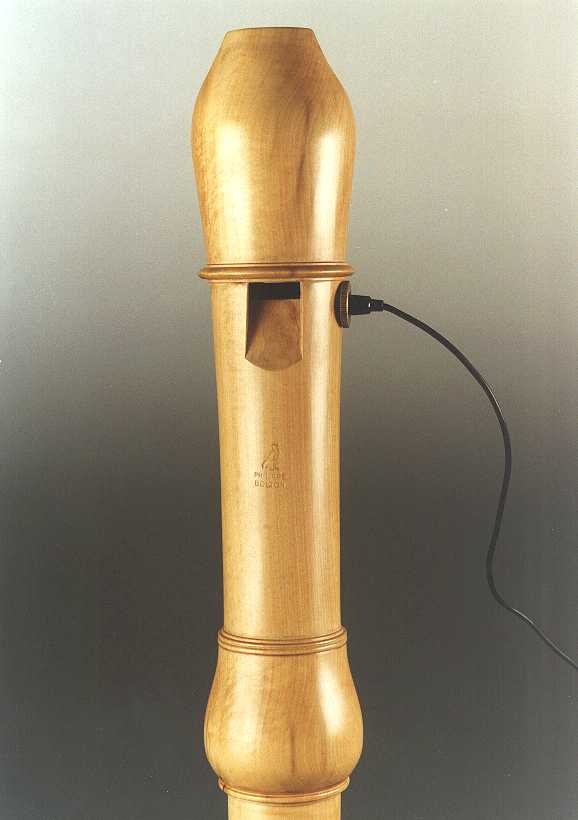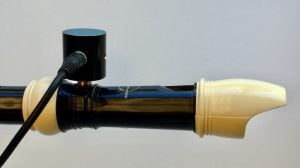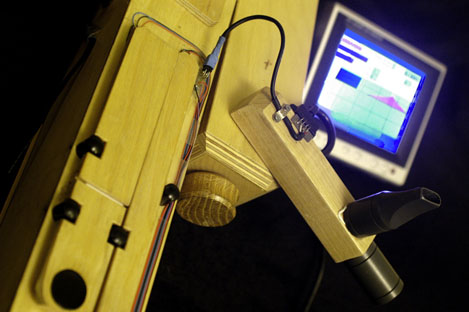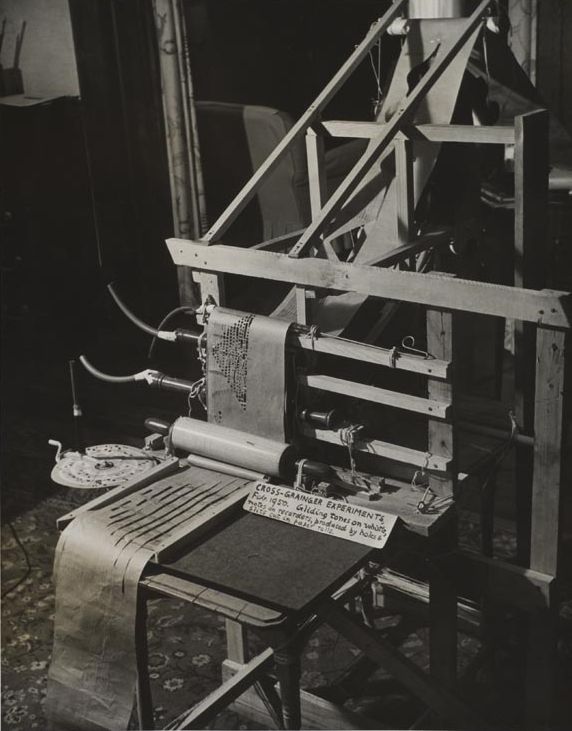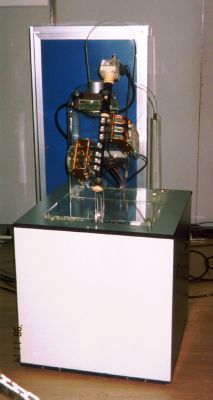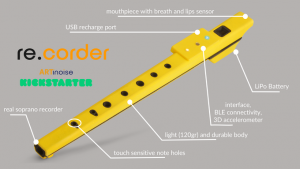There have been a number of attempts to re-design the recorder and extend its capabilities for use in a contemporary context. However, even virtuosi have, for the most part, preferred instruments designed after historical (i.e. pre-classical) models.
Keywork
As early as 1636 Marin Mersenne (a French polymath, whose works touched a wide variety of fields) advocated the use of extra chromatic keys on recorders (see Schmidt 1959: 25), a suggestion not explored until the 19th century with the development of what later became the Wiener csakan in about 1820, a recorder in a♭’ with a thumb hole and seven tone-holes, originally with one key, later with up to 11 keys, culminating in the development of the Komplizierte Csakan. Csakans were mainly built in Vienna and Pressburg (modern-day Bratislava) between 1820 and 1860. A smaller version in c” was being made in the Vogtland region as late as c. 1900.

Peter Thalheimer (2013: 28-29) has described how, as the early twentieth-century revival of the recorder gained momentum, flautists who began to play the recorder wanted to have an instrument fitted with the familiar keys rather than having to get used to historical forked fingerings. Thus, after c. 1930, several workshops started to offer recorders with between three and six semitone keys, among them German instrument-makers Oscar Adler, Max Hüller, Ludwig Schlosser, Martin Kehr, and Karl Hammerschmidt & Söhne.

The German firm Johannes Adler made keyed recorders in c” as late as the 1960s.
In 1936, the Gustav Herrnsdorf firm acquired the right to protection of a c”-recorder with a b♭’ key, (D.R.G.M. 1 362 864). This new key operated by the little finger of the uppermost (left) hand and it also made an easy speaking low c#’ possible. The impetus for this came from modern reed instruments, all of which are equipped with downward extensions below the fundamental. However, downward extensions to the recorder’s range were explored in the 16th century, e.g. by Hans Rauch von Schrattenbach and by members of the Bassano family, though this might not have been known in the 1930s. The use of extension keys would be introduced yet again by Joachim Paetzold (1966) and Maarten Helder (1996) and then transferred to the Mollenhauer-Paetzold Tarasov recorder and, more recently, to the Breukink-Bollinger “Eagle” recorder which we will meet below.
Early 20th-century innovations include the addition of a key applied to an otherwise more or less conventional recorder to close the bell of the recorder in order to facilitate the production of certain high notes and to adjust the tuning of others (see Fingering the Recorder). End-stopping of the bell of the recorder had been mentioned by Agricola (1529) and Cardano (1546), so there are historical precedents for its use. In the absence of a bell key, it is hard to do unless the player is seated. A bell key as such was probably first made in 1953 by John W.F. Juritz, a physics lecturer and bassoonist in Cape Town, whose invention was not patented (Waitzman 1968, Thomas 1998). A bell key designed by Carl Dolmetsch in 1957, and first used by him publicly in 1958, involved plugging the bell opening itself and letting a new hole in the side of the foot which was covered by a key operated by the little finger of the lower hand. This side-mounted key was the subject of British Patent #852165, 8th June 1959, based on a 1958 application, although the text of the patent application also mentions the alternative strategy of closing or partially closing the bell opening itself (Thomas 1998, Madgwick and Loretto 1996, Loretto 1998). A less successful Carl Dolmetsch invention was a similar side-mounted closed key operated by the little finger of the uppermost hand which made possible a tongued f#”’, the subject of British Patent #852164, also granted on 8th June 1959 (Thomas 1988). Later, a key was designed by Dolmetsch which covered the bell opening itself and which could be operated by the little finger of the lower hand or, more usefully, by that of the upper hand.
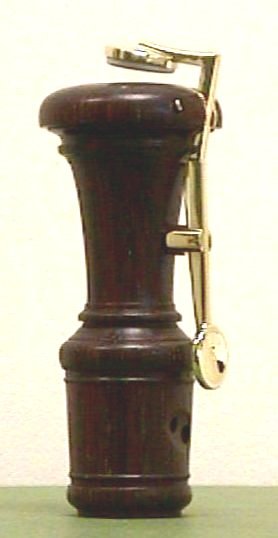
In 1958, Edgar Hunt constructed an experimental long bell key, operated by the little finger of the left hand, like the long F key of the 18th-century keyed flute and modern oboe (Hunt 1961, Waitzman 1968). The left-hand little finger depressed a lever to pull a wire which passed through the bell of the foot joint to pull a key against the hole. Also in 1958, William (not John) Koch of Haverhill, New Hampshire, USA, was using a bell key to obtain additional notes on his bass recorder (Waitzman 1968, 1969). Tsukumoto (1975) built side-mounted bell-keyed recorders with a lengthened foot which obviates the closure of the bell opening itself. This could be made to be operated by the little finger of either hand. The end-mounted bell key was applied to a substantially re-designed recorder which adopted a dramatically different fingering system unsuccessfully championed by the American player Daniel Waitzman (1978).
The ‘OrKon’ or ‘Chromette’, invented in 1941 (US Patent #2330379) by Edward Verne Powell (1903-1986), the son of V.Q. Powell the famous New York flute maker), was essentially a modified soprano recorder moulded in bakelite with metal reinforcement rings and fitted with a simplified Boehm system keywork. Its lowest notes could be blown loudly as well as softly with minimal pitch change and the chromatic scale was much facilitated by the keywork. Although the Orkon was intended to be mass-produced for use in schools as a preparatory instrument for potential flute players, the venture failed (Huene 1994, Jerome 2002, Burgess 2015: 63).
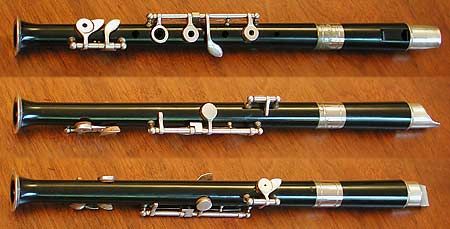
Japanese musical instrument manufacturer Nikkan (acquired by Yamaha in 1970) advertised a keyed recorder in the September 1957 edition of the magazine Ongaku-no-Tomo for which a patent was applied for on 25 February 1960 and issued by the Tokyo Patent Office on 7 February 1963 (record 38-1528). From the illustration this instrument appears to be a recorder with a semitone hole for the little finger of the lowermost hand and two keys operated by the little finger of the uppermost hand, presumably to extend the range downwards (Henseler and Otse 2010: 16).

In 1984, an application for European Patent 0138231 was filed for a fully keyed recorder by the saxophonist Arnfred Rudolf Strathmann of Memsdorf and granted i1987 (see also United States Patent 4664011), Strathmann’s recorder featured the elaborate keywork and fingerings of a saxophone. With the assistance of the Klein company Kiel, a series of Strathmann flutes was developed with many modern features. The body is made of wood or durable plastic, the block height is adjustable with a simple thumbscrew, and the thumb hole is replaced by a key that opens two small holes high up in the headpiece which raises any fingering of the lower register to the octave above. The volume of sound for all notes is stronger than on conventional recorders, and the timbre is said to be between that of a recorder and flute (Huene 1994). These instruments have been made in both soprano and alto models. After the Klein company collapsed, Strathmann continued to make these interesting instruments alone, in small quantities until his death in 2016. Strathmann flutes found favour with a number other jazz musicians, amongst them Fiete Felsch, Klaus Doldinger, Herb Geller and Steffen Schorn.
The firm Mollenhauer have recently incorporated in a newly designed alto recorder the adjustable block (ie a tilting windway) patented separately by Strathmann in 1992 (United States Patent #5107740; European Patent #0431344).
In 1996 Strathmann patented a device in the block, operated by the lower lip, which alters the pitch of the recorder by up to 5 cents. The device is based on the principle of the universal semitone key, which was already used on recorders in the 1930s (Moeck 1997, Thalheimer 2013).
It is worth noting that it has long been possible to fix a recorder-like head joint to a keyed flute. L’Encylopedie (Diderot & D’Allembert 1751-1772) includes a description and illustration for a flûte traversière et à bec which is side-blown through a laterally placed hole (a) and has flute fingerings, with a d# key (8) and an octave hole (1) opened by pressing the upper key:

Surprisingly, a similar but keyless instrument appears in a painting made a century earlier by Joos van Craesbeeck (?1605/6 – 1654/61), namely The Mandoline Player, present whereabouts unknown. Here, the ‘mandoline’ is actually a lute.
In the early 1930s the German firm of Carl Kruspe offered a fully keyed Schnabelflöte provided with both flute and recorder head-joints made by Max Hüller (Thalheimer 2013: 44).
Specially designed head joints have been made to fit any modern concert flute by Martin Niethammer and Nick Metcalf, amongst others. The result is an inexpensive, fully chromatic instrument that will play with great agility over two or more octaves.
Most recently this idea has been explored exhaustively by Martin Educciman and further developed by Alex Müller who designed the Fliphead head joint.
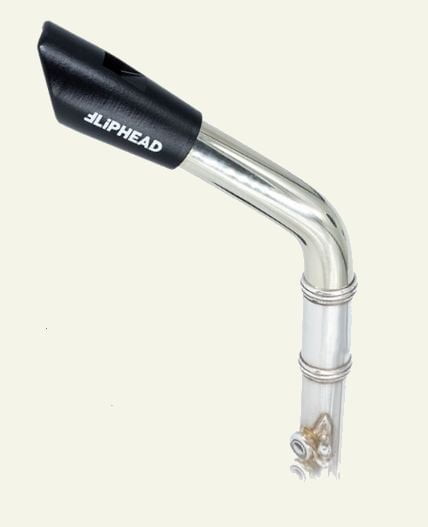
A similar (straight) head joint is available from Chris Abell, whose Whistle Headjoint is manufactured from tropical hardwoods and Sterling silver, reviewed by Gina Luciani here.
For DIY enthusiasts, Martin Educciman (see above) gives instructions for fitting a conventional alto recorder head joint to a concert flute by means of a suitable tenon.
Volume
In 1930 Carl Dolmetsch introduced the echo or piano key operated by the chin or little finger of the left hand which opened a small hole in the block of the recorder by means of a plunger and raised the pitch of the instrument a semitone thus making it possible to play very softly with diminished breath pressure as well as facilitating chromatic playing. This method was later abandoned in favour of a small additional hole in the rear side wall of the head behind and opposite the main slot in the window. The latter modification was also patented in 1958 (British Patent #852135), though it derives from the side-mounted echo key of certain eighteenth- and nineteenth-century flageolets (see Bolton 2025: 15 & fig.) A similar device patented by Max King & Sons in Zwota (Patent DRP 671 814, dated 26 January 1937) was fixed to Herwiga ‘Pan’ recorders.
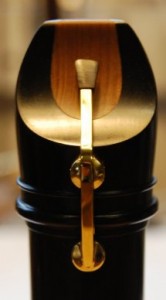
Moeck offer a modern recorder designed by Dutch maker Adriana Breukink and marketed as the Slide Recorder. This instrument is similar to so-called Ganassi recorders but incorporates a specially designed slide mouthpiece for the production of dynamics and microtonal playing. In the Breukink/Moeck design, a spring-loaded pad operated by the player’s lower lip activates a plunger that opens a hole in the face of the block, a variant of the first of echo/piano keys developed by Dolmetsch in 1930 (see above).
Similarly, Geri Bollinger offers recorders with “le Souffleur”, a hole drilled through the block which can be opened or closed with the player’s lower lip thus permitting a greater dynamic range. Obviously, any make of recorder can be modified in this way. The piano or whisper key has been applied to the Harmonic Tenor Recorder and the Eagle Recorder, both described below.
Carl Dolmetsch also invented the so-called “tone-projector” (British Patent #666602), a wooden wheelbarrow-shaped attachment that clipped onto the window of the recorder’s headpiece to focus the tone and project it forward in an attempt to give the recorder more volume. Initially, these were made from rosewood or satinwood by Michael Heale (then an apprentice at Dolmetsch) who manufactured them as overtime work (Cave 2003). The tone-projector, first used publicly by Carl Dolmetsch in 1949, was later replaced by a plastic model in two sizes, one for sopranino and soprano, the other for alto and tenor (Ward 1949).
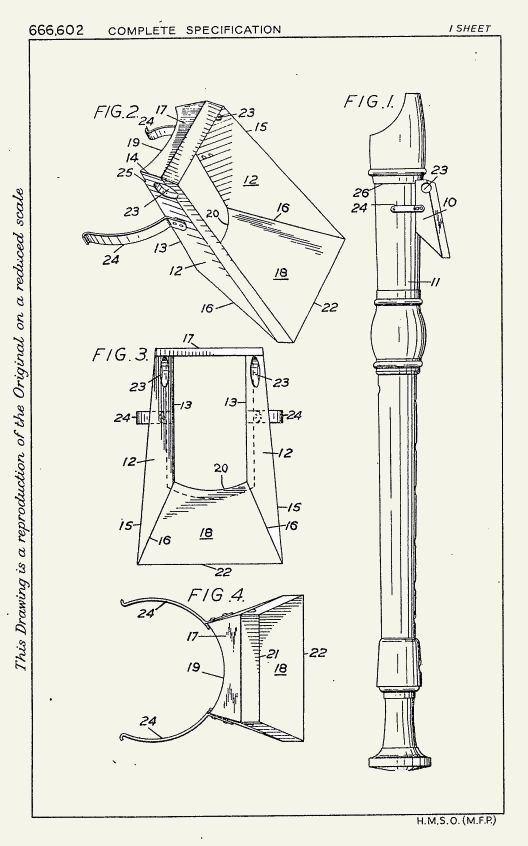
All of the above innovations leave the recorder essentially unchanged and it can still be played like any other recorder until the player has good reason to bring them into use (see Dolmetsch 1996, Madgwick and Loretto 1996).
Over a period of 25 years Klaus Grunwald, a painter and art teacher living in Cologne developed Trichterflöten, or “bell recorders”, largely for his own use. He sought a keyless recorder that would project well in large indoor spaces and hold its own with modern instruments. Working largely with simple tools such as files, rasps, drills, and hot air guns, Grunwald made some 80 prototypes ranging from sopranino to great bass, at every conceivable pitch, and from a variety of materials. Grunwald’s recorders were similar in appearance to renaissance recorders, with a wide, largely cylindrical bore, a simple external profile, and large, single tone holes. The crucial difference was the incorporation of a large, widely flared exponential bell (of wood or metal) similar to that of a clarinet. Another feature was a raised finger hole for the lowest finger, added for ergonomic reasons; this can be seen, too, on the Wiener csakan (c. 1900) illustrated at the top of this page. Grunwald was besieged by orders for his unique instruments but really had no desire to replicate them for commercial sale. Eventually, a contract was signed allowing the Adler-Heinrich firm to produce instruments to Grunwald’s design under his supervision until the firm foundered some years ago.

A novel solution to the problem of recorder dynamics has been suggested by English flute maker Clive Catterall who offered a specially designed notch-flute of cylindrical bore but with recorder fingering. The resulting instrument, similar to the Japanese shakuhachi and the Andean quena, is played by putting the head against the lower lip and chin so that the edge is level with the gap between the lips. Formation of the lip shape, angle of blowing and air pressure must be learned, as with the transverse flute. The thumb hole can be used in the same way as it is on the recorder or the shift between registers can be done with the embouchure alone, it is up to the player. Catterall no longer makes flutes, but it is possible to make such an instrument yourself from a plastic soprano recorder with a single saw cut.
Another Dolmetsch innovation was the recorder mute, a narrow fold of paper hooked over the labium of the recorder first described by Carl Dolmetsch in Part 3 of The School Recorder Book (Dolmetsch 1974). In fact, these are best made using the smooth soft plastic material of which the recording surface of 5¼-inch floppy diskettes are made (Delong n.d.). An adjustable mute for the soprano recorder has been developed and marketed by Italian plastics manufacturer Bonini as Sordinella.
Solutions to the condensation problem
A solution to the perennial problem of condensation in the narrow windway of the recorder and its relatives has long been sought. Both English and French types of flageolets made use of a wind chamber in which a sponge is placed to absorb moisture from the breath passing through it. This has the added advantage of creating resistance to the player’s breath. Nineteenth-century csakan makers developed a number of novel approaches (Tarasov 2005). Carl Doke of Linz and Martin Schemmel of Vienna introduced a thin wooden wedge into the windway. Franz Schöllnast of Pressburg and Johan Ziegler & Son of Vienna drilled two small holes into the side of the block, draining into the channels below. Stephan Koch of Vienna adopted a hollowed-out block to collect moisture which drained out via a small tube, the dried air passing into a normal windway.
In the 1940s or 50s, Schott produced recorders with a plastic block which sat in a very thin, fragile, wooden tube and a white plastic beak which slipped over both to form the top of the windway with drainage gutters down each side of the block (Malcolm Tattersall, pers. com. 2025).
A 1962 patent application (USA Patent #3178986, German Patent #1235122) was made by Hermann Moeck which shows how the windway was to be lined either completely or in part by stable, moisture-absorbing materials. The final patent registered in 1974 (USA Patent #3988956, German Patent #2432423) used a different design in which an absorbent and very stable artificial chalk-like material was inserted into the floor of a normal wooden block. However, the ceramic material from which the absorbent insert was made eroded in response to the ghastly cocktail of food and alcohol present on the average recorder player’s breath, necessitating expensive repairs. Improving on this line of attack, Mollenhauer introduced Synpor, a synthetic block material that absorbs moisture without changing dimension (Burger and Tarasov 2001).
The American recorder maker Friedrich von Huene fitted a silver sleeve over the labium of some of his early recorders in an attempt to check the buildup of moisture, but this was only partially successful (Burgess 2015: 78), presumably because the problem resides in the windway rather than on the labium of the instrument.
A number of makers have experimented with a system of longitudinal grooves in the windway floor to facilitate the flow of condensed moisture away from this sensitive area (Stephenson 1987). The latter idea, inspired by certain Markneukirchen recorders made early in the 20th century, has been implemented in plastic recorders and in soprano and alto instruments designed by Hohner for school use.
Most recently, French recorder-maker Vincent Bernolin has adopted a three-pronged assault on the condensation problem. The blocks of all his instruments are made from cedar treated by an exclusive procedure devised by physicist Arthur Gohin. Furthermore, Bernolin places an expansion joint between the block and the wood of the head with which it comes into contact which absorbs residual moisture. He also offers instruments in which the block is prepared with a more sophisticated treatment of his own devising.
Extreme sizes of recorder
Some makers have experimented with recorders of extreme size. Perhaps the largest renaissance-style recorder ever made is sub-contrabass in B♭1 by the late Adriana Breukink. The only historic recorder of comparable size, in the Vleeshuis in Antwerp, made by Rauch von Schrattenbach (c.1535) was, in fact, a sub-bass in F2 with an “extension” to C2 with keys that have to be played with the little finger and thumb. Mersenne (1636) mentions a recorder with keys that could be played with the feet or by another player. So there appear to have been different versions of this giant!
At the other end of the spectrum, Frans von Twaalfhoven’s ‘piccolino’ recorder in f”’ (an octave above the sopranino) is probably the smallest fully functional recorder ever made. To make it playable, the finger holes for each hand are on a separate axis. It has a thumb hole. Although the player’s fingers are effectively interleaved, the expected patterns for each hand still apply.
Even smaller recorders, made as novelty items or jewellery by Kobliczeck and by Mollenhauer, can actually be sounded; when she was a child, my daughter was able to coax simple tunes from one of the latter, much to my astonishment.

by Mollenhauer
New materials
In the early 1970s, Gyula Foky-Gruber in Vienna developed the ‘Silberton’, an all-metal soprano recorder made entirely of nickel-plated brass, and an alto made of rosewood with a metal head-joint and two keys for the lowermost finger hole. Both featured a system of adjustable voicing achieved by altering the position of the block and the height of the windway. Both had a cylindrical bore. Later, the German firm Amati produced a look-alike ‘Silbertonflöte’. Similarly, Hopf continued to produce metal instruments offered as ‘Gruber System’ recorders in sopranino, soprano, and alto models.
Recently, an all-metal (aluminium) recorder has been made by USAmerican instrument maker John Orth.
Plastic has been used for hand-made recorders as well as for production models. Loretto (1993) relates an apocryphal tale to the effect that one of the pioneers of the German recorder revival, Ferdinand Conrad succeeded in convincing Martin Skowroneck to make a plastic instrument for him. Skowroneck, anxious that such a recorder not be played in public, made it of a violent blue-coloured plastic, a feature that would be considered a virtue by today’s players! Indeed coloured recorders are now made by the firm Mollenhauer, amongst others. Vincent Bernolin offers exceptional quality hand-finished recorders after Stanesby Senior made in resin with a cedar block. Colourless recorders in transparent plexiglass have been made by Thomas C. Boehm, Pietro Sopranzi, and Frans van Twaalfhoven.
Some years ago, Yamaha introduced their 400 series recorders which are identical in acoustical design to their 300 series but made of a new ecologically friendly composite material named Ecodear, which consists of 70% ABS plastic resin and 30% PLA resin derived from plants – all previous models have been made of 100% ABS plastic. These new instruments are yellow in color and similar to boxwood in appearance, with white imitation ivory trim similar to that in the 300 series instruments.

Francesco Li Virghi and Marco Piga have made ceramic-headed recorders after Stanesby. An enterprising amateur maker, Joseph S. Wisniewski, has experimented with glass – not that this is new: the inventory of Vittoria Vellia dated 1 November 1615 in Rome included two recorders made of purple glass (Lasocki 2005: 500).
A number of makers have made recorders from composite materials. In 1933, Rudolf Otto in Markneukirchen patented a recorder with an ebonite beak and block and, in the same year, Wilhelm Jan in Zwota patented a recorder with a one-piece celluloid beak (Thalheimer 2013: 122). Recorders with Acolit (phenolic resin) head-joints and wooden bodies were made as early as 1940 by the Markneukirchen firm of Oscar Adler, namely their “Sonora” model soprano (Thalheimer (2013: 121). Today, Mollenhauer makes a ‘Prima’ recorder with a plastic head and a wooden body which has found favour amongst players interested in popular music, eg Jean-François Rousson (France), Evelyn Nallen (UK). A similar model is offered by Moeck as their Flauto 1 Plus model. Hohner markets a Melody model with a plastic head and pearwood body.
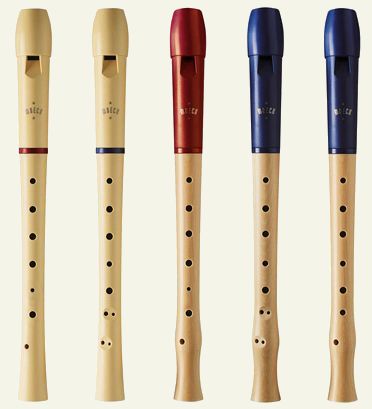
The neo-renaissance ‘Dream’ recorders designed by Adriana Breukink and manufactured and marketed by Mollenhauer are available in brightly coloured wood stained red, blue, and green, primarily to appeal to children, as well as in a natural finish.
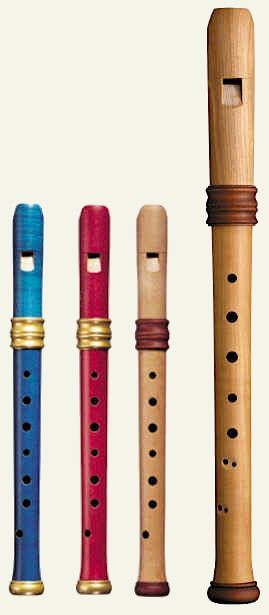
Recorders for children
Several makers have modified the recorder to render it more suitable for children. Thus Joachim Kunath, has designed 5-tone and 7-tone pentatonic recorders, diatonic recorders, and special soprano recorders for use in Waldorf (Steiner) schools.
Similarly, Choroi Instruments offer diatonic and pentatonic recorders, and so-called interval flutes with only one finger hole and two notes each. Moeck offers a pentatonic recorder, their Flauto Penta. The Suzuki Precorder PRE-1 is a two-piece plastic recorder with raised tone holes for pre-school use, rather like the American Tonette.
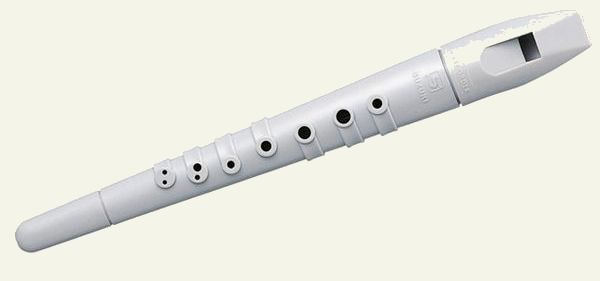
Swiss maker Huber has recently introduced two half-recorders, namely the Soprina and Tenorina, which are provided with holes for the left (upper) hand only. The soprina allows young beginners to focus on the movements of the fingers of one hand; the tenorina is suitable for somewhat older children, who prefer warm sounds.
Battle of the Blocks
American recorder maker William F. Koch (1892-1970), whose instrument-making business was founded in 1934, manufactured a basset recorder with a unique horizontal windway, presumably in order to render it direct-blown with improved response and to shorten the instrument.
Basset recorder, by Wiliam Koch, showing horizontal windway
English recorder player and maker Robin Read (1966) carried out a number of experiments in the early 1960s resulting in a tone generation assembly of cedar constructed as a separate entity with the windway floor formed from a conventional plug. Advantages of this innovation include more accurate control of windway dimensions and better resistance to condensation (from twice the normal surface area of cedar. This novel windway design was coupled with a separate tongue which was adjusted before fixing in place, thus reversing the normal voicing procedure.
New Zealand maker, the late Alec Loretto, designed a rotating head with a chamber containing a selection of windways much like the chamber of a six-shooter rotates into position. And the same maker built recorders with a large slot instead of a windway into which prefabricated windways could be fitted, all with identical exterior dimensions, but each containing its own windway optimised for the pitch of the notes being played (Madgwick and Loretto 1996: 41-42). He also experimented with an adjustable labium on a contrabass recorder in F, allowing changes to be made to the distance of the labium from the windway, the position of the labium in the airstream, and the angle of the labium in the airstream (Loretto 1970).
An innovation from Hohner was a recorder with a wooden body and head but with a flimsy plastic insert that formed the upper windway and cutting edge of the labium.
Some of the Australian Pan recorders (made by a young Fred Morgan working with ‘Lazy’ Ade Monsbourgh and Don ‘Pixie’ Roberts) featured a combined plastic block and windway in order to address the difficulty of making wooden windways and blocks accurately enough for a decent sound and cheaply enough for a mass-market instrument. Initially these plastic units were glued in place (Tattersall, loc. cit.); however, an example formerly in my own collection (Australia-Sydney: Powerhouse P.1198/1) slid in and out of the beak as a single unit, possibly due to glue failure, or deliberately so it could be more easily cleaned.
Italian maker Giacomo Andreola offers recorders with a specially constructed beak (which he says he copied from an idea of the recorder maker Claude Monin) which allows the player to change the windway as needed, either to vary the voicing of the instrument or in order to overcome condensation problems.
The Mollenhauer/Helder Harmonic recorder incorporates a removable windway system, a lip-operated mechanism that can raise or lower the floor of the windway during playing, and an adjustable block that slightly alters the depth of the windway exit and the height of the windway roof above the labium. The result enables extensive experimentation with the sound produced by the instrument.
In a sense, these experiments with adjustable blocks were anticipated by French organ builder Aristide Cavaillé-Coll (1840) who suggested that the historic recorder could have been improved by a sliding bevel operated by a system of keywork (Reinhardt 1984).
Long bores
Swedish maker Ragnar Arvidsson built novel recorders of his own construction and design with a unique bore derived from his engineering experience of microwave waveguide systems in radar and telecommunication equipment. With the timbre of renaissance recorders but played with neo-baroque fingering, these recorders have a full chromatic range of 2 octaves, plus some extra high notes (Hulthèn 1997).
A study of certain pre-war German recorders with unhistorical long bores and the characteristic that over-blowing the bottom or second note produced a true set of harmonics drawn to his attention by recorder player Nikolai Tarasov, has led the American maker Friedrich von Huene to explore the use of additional keywork to close fairly large tone holes far down the instrument out of reach of the little finger thereby extending the range downwards and creating many new fingering possibilities for higher notes. A tenor recorder made along these lines has a range of two octaves and a sixth from b to g#”, the same as a modern oboe. Some of these features appear to have been incorporated into the Yamaha YRT61M tenor recorder.

Tarasov collaborated with Maarten Helder to construct a recorder with harmonics tuned in such a way as to make it possible to play very strong and stable low notes with a tone quality matching that of its higher registers. Indeed their so-called Harmonic Tenor Recorder boasts a range of three octaves from b-c””’, with 4 keys and an optional piano key. It also implements the adjustable block patented by Strathmann, though here it can be adjusted by a twist of the hand, even during a short pause, allowing the player to alter the voicing for maximum tone quality or special sound effects.
The Harmonic Alto Recorder, a companion instrument to the Harmonic Tenor Recorder, with similar range, features, and performance characteristics, is now available. Like its predecessor, this unique and radically new instrument is a collaborative effort between the Dutch recorder maker Maarten Helder and Mollenhauer. A novel feature of this instrument is the inclusion of a number of interchangeable windways. These may be of different materials or different shapes. Like the Harmonic Tenor Recorder, the Harmonic Alto Recorder also includes an adjustable block and a sophisticated keywork for the lower tone holes.
Recently, Mollenhauer in cooperation with Susanne Fröhlich has launched a highly revised version of the Helder Harmonic Tenor Recorder which they call the Helder Evo Tenor recorder. Amongst many improvements, this instrument extends the range further from b to e””’. The tones of the instrument’s foot-joint now overblow to their natural partials, thus stabilizing the recorder’s sound in any register, rendering it more flexible in combination with modern orchestral instruments. A metal tuning slide allows a secure intonation within a wider pitch range. The Sound-Unit now allows many tonal parameters to be regulated either before the playing or altered during the performance. The piano or register key has been improved to better facilitate variable pitch control as well as the response of the highest registers. The middle joint is now equipped with alternative keys for f, f#, and g#. Several new features support a perfectly balanced playing position, namely the knick-system head-joint, the vertically and horizontally adjustable special thumb rest, and the elastic neck strap.
Tarasov has also collaborated with Joachim Paetzold to create the Paetzold-Tarasov Modern Alto Recorder with a range of two and a half fully chromatic octaves from f’ to c”’. This has been further developed and refined in the Mollenhauer workshop. This instrument has a full, resonant, and uniform tone quality throughout its range with outstanding projection and response, is ideal for performing music of the late 18th century and 19th centuries, and contrasts well with historical or modern pianos. It can be heard on Tarasov’s CD, The Modern Alto Recorder, and is played by a number of the world’s leading recorder virtuosi, notably Michala Petri.
Adriana Breukink and Geri Bollinger together with Küng have developed a striking new instrument they call the Eagle Recorder which combines many of the innovations in recorder design made over the past decade or so. The Eagle alto recorder, launched in 2013, combines equally strong low and high registers, flexible dynamics, and an extended range (e’– c””). It features a wide bore, a metal labium (as found in certain renaissance recorders), a triple foot-key, and an octave key.
The Eagle recorder can also be fitted with a chin-operated slide mechanism to further control volume and intonation.
How ironic it is to note that the hitherto scorned work of the German recorder makers of the 1920s and 1930s should actually have provided the springboard for what may well prove to be the most significant developments in the recorder’s history since the seventeenth century!
Square bore profile recorders
Over the past decade or so the square-profile recorders have become enormously popular. First designed and made in 1953 by Joachim Petzold, based on the principle of a cranked tapered organ pipe, their design was patented and further developed by Joachim’s nephew Herbert Paetzold in 1975. Their ease of construction, requiring little more than a decent mitre saw, a measuring tape, and some clamps. Their use of inexpensive materials lend themselves particularly well to the larger sizes of recorder and render these otherwise very costly instruments more affordable to a wider range of players. Furthermore, their tone is impressively strong in the lower register and they speak easily over two or more octaves.
These wonderful instruments are capable of an extraordinary range of timbre, attack, and other sound effects and have become the ‘axes’ of choice for recorder players exploring what in my day used to be called musique concrete, these days known as “contemporary music”.
In 2012 the rights and production of the square-profile Paetzold bass recorders were transferred to the workshop of Joachim Kunath, their name changed to “Paetzold by Kunath” and the workshop itself relocated from Ebenhofen to Fulda. They are now made in the following sizes: tenor in C4, basset in F3, bass in C3, sub-bass in F2, contrabass in C2, double sub-bass in F1, and double contrabass in C1. Each has a full two-octave range. Now 16-foot, 8′, 4′, and 2′ pitched sets of recorders are available for consort, recorder choir, or continuo use. Whilst it is tempting to think of a hyperbass recorder in C0, Joachim Sickert (pers. comm., 2022), who owns a complete set of Paetzold recorders, comments that from a purely physical point of view, a recorder lower in pitch than C1 would no longer be playable. Construction materials used in Paetzold by Kunath recorders include birch, cherry, mahogany, and RESONA. The latter is a synthetic composite with a similar density to rosewood but made from renewable raw materials. The range incorporates many innovations, including the option of a direct-blown mouthpiece.
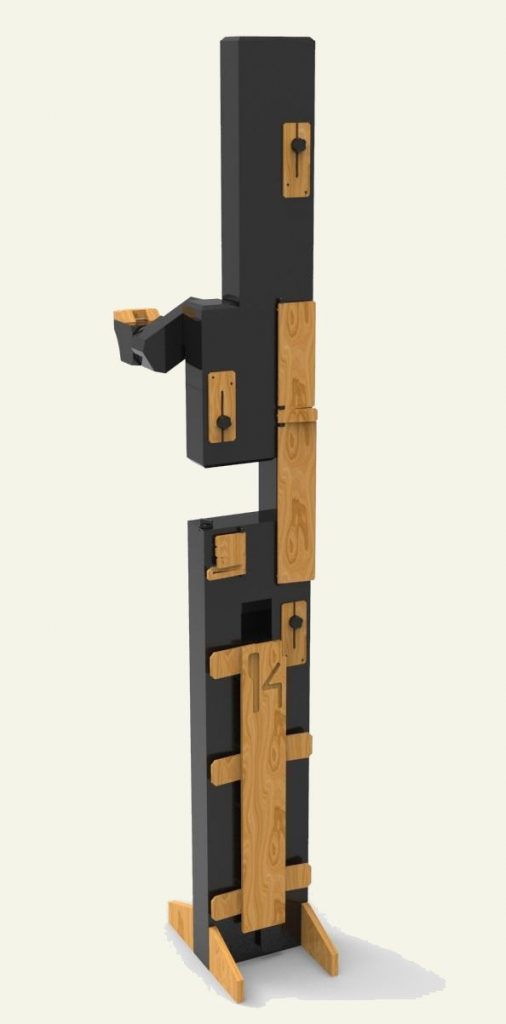
Independently from Joachim and Herbert Paetzold, New Zealand maker Alec Loretto built an experimental square-profile bass recorder in 1967, a photograph of which was published by him in 1970 (Loretto 1970, Madgwick & Loretto 1996), although it lacked keywork of any kind. Dolmetsch also adapted the square-profile approach to their own range of Millennium Series bass recorders which were furnished with conventional woodwind keywork.
At the same time as Harlan initiated the Recorder Movement in 1928, the construction of bamboo recorders was introduced in Germany (Schuman 1952). Hitherto, (including in Germany) bamboo flutes had been made with six fingers and one thumbhole and continued to do so, but Schuman’s instruments were based on the eight-holed recorder and adopted Harlan’s “German” fingering (Thalheimer 2021). They were made in various sizes, amongst them tenor and bass instruments of square profiles, illustrated by Christoff Schellenberger (c.1955).

illustrated by Christoff Schellenberger (c. 1955).
Alec Loretto gave instructions for making DIY square-profile “medieval” soprano and alto recorders (Loretto 1996a&b, 1998). But perhaps he was anticipated in this by actual medieval forerunners of his craft.
One of a series of anonymous 14th-century painted limestone carvings in the musicians’ gallery of Exeter Cathedral depicts a musical angel who appears to be holding a duct flute which is square in cross-section, though I note that these carvings were restored in 1976 ( Kinsky et al. 1930: 51, Cave 1953: 60, Crispin 1968: 358-9, Early Music 1987 front cover).
An anonymous 15th-century manuscript (F Lm 391, f. 28) depicts a man in what looks like a bowler hat playing a duct flute which is decidedly square in cross-section.
A second 15th-century depiction of a square-profile recorder can be found in a copy of Christine de Pisan’s L’Epître d’Othéa (ca 1406), namely Midas Judging the Contest Between Pan and Apollo, an illumination by the Master of the Epistle of Othéa (F 606, f. 14r.)
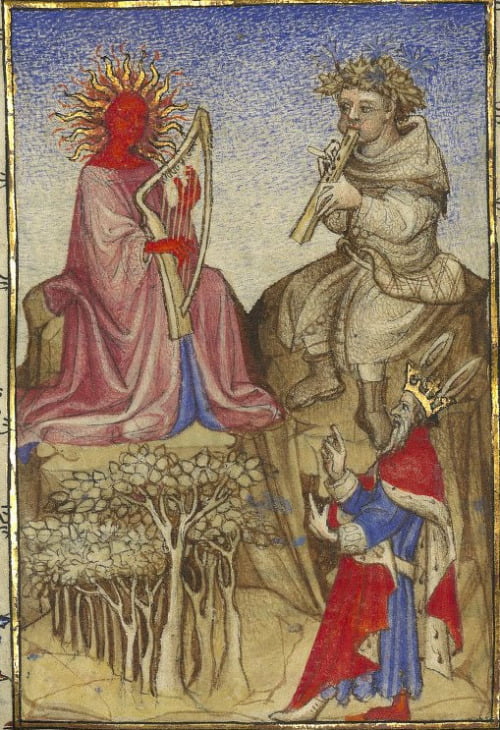
A third 15th-century square-profile recorder has been clutched for some 700 years by a monkey in an anonymous stone relief in the cloister of the Monastery of San Juan de Los Reyes, Toledo. A notable feature of this version is the placement of finger holes for each hand on adjacent faces of the body of the instrument.
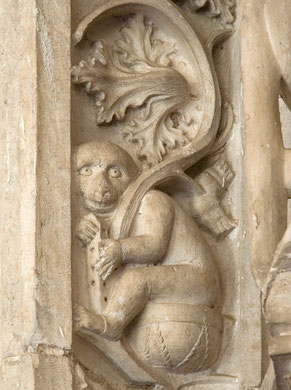
Monastery of San Juan de los Reyes, Toledo
Note that the artists in all four of these 14-15th-century depictions seem perfectly capable of rendering curved surfaces and edges where they wished to.
Serpentine bores
Sigo, another highly innovative recorder developed by Swiss recorder designer & maker Geri Bollinger, is now manufactured & marketed by Kunath. Its complex serpentine bore, retroflexed head joint & reflexed foot, compress a tenor recorder into one not much longer than a soprano thus bringing the finger holes much closer together than those of former design.
The Sigo recorder is made of light-weight RESONA, a material developed from renewable raw materials, which can be 3-D printed. The timbre is conventional in quality with contemporary ‘baroque’ fingering. Alto & basset models are under development.
Microtonal recorders
The American composer and recorder player Tui St George Tucker (1924-2004) employed a system of alternative recorder fingerings for the purpose of executing quarter tones (Tucker, undated). She is also said to have developed a recorder with extra finger holes for this purpose (Wikipedia 2013).
Under the auspices of the Centre for New Musical Instruments (CNMI) at London’s Guildhall University (now London Metropolitan University), Lewis Jones together with David Armitage designed and, in 1999, built two prototype, 19-division equally tempered tenor recorders for the performance of microtonal music (or other music composed in alternative tuning systems) and as a new form of expression. These keyless recorders were based on wide-bored renaissance models. Later, in 2001, they were further developed with five small keys operated by the little fingers of each hand. Recorder players Katherine Bennetts and Peter Bowman worked with these instruments over several months but found the positioning of the keys awkward, and they were unable to perform with them (Bowman 2014: 89).
Inspired by Leonardo da Vinci’s fissure flutes proposed in 1498 (see Lander 1996-2025), and a number of continuously variable pitch reed instruments developed in the 1920s, American Bart Hopkin created his ‘Moe experimental family of instruments in the 1990s, including the ‘Moe clarinet, saxophone, membrane pipe, and flute (Hopkin 2021). The latter actually incorporates a tenor recorder head joint.
The front surface of the body of the ‘Moe flute has a fissure, above which is suspended a leather strap held in place by an adjustable fastener. Different pitches are produced by pushing down on the strap at different points on the tube to lower the sounding length of the instrument (Hopkin 2021, 2024a&b).
Similarly, Hungarians Dániel Váczi and Tóbiás Terebessy combined forces in 2016 to explore new possibilities in woodwind musical instruments. Their first prototype was quite basic: a bamboo tube with a slot and a fridge magnet attached to it, combined with the mouthpiece of a saxophone. Over the following years, Dániel and Tóbiás worked closely with a team of instrument makers to refine the instrument’s design, materials, and components, and a production model Glissotar was launched in 2024, in essence a continuously variable pitch tárogató. Váczi & Terebessy (2024) write that the glissonic system can be used on various wind instruments: flute, recorder, clarinet, saxophone, tarogato, oboe, or even the cornetto. Currently under development are a Glissoboe and a Glissoflute (Váczi & Terebessy 2024). A Glissorecorder would open up a new world of microtonality hitherto difficult to access using the conventional instrument.
Electro-acoustic recorders
Fajardo (1970) described fitting an alto recorder with a microphone and reverberation unit, but this innovation long remained an isolated case. French recorder maker Philippe Bolton has developed an electro-acoustical recorder for contemporary music, jazz, etc. (patent pending) which can be amplified, or played without amplification. There is a hole in the side of the bore at the top of the head joint into which a microphone can be screwed. This can be connected to a PA system, giving the musician the possibility of having a louder instrument for playing in difficult conditions, or in an ensemble with loud instruments (jazz for example), without having to stay rivetted a few centimetres in front of an external microphone.
The electro-acoustical recorder can also be connected to an effects processor, giving a very wide palette of sounds for use in contemporary music, or any other contexts in which such effects can be useful. For complete freedom of movement, a wireless system can replace the traditional cable leading to the amplifier. When no amplification is required a special plug can be screwed into the instrument instead of the microphone, converting it into a normal recorder. For a review of the use of microphones with recorders see Dessy & Dessy (2001).
Japanese recorder maker Yukio Yamada has made an electronic device that will transpose the recorder two or three octaves above the pitch you play (Epstein 1988: 8). This facility is also available on the Bolton electro-acoustic recorder attached to an effects processor or MIDI device.
More recently, Nikolkaj Tarasov in conjunction with Mollenhauer has developed an electronic and acoustic recorder marketed as ‘Elody’. Like the Bolton electro-acoustic recorder, the ‘Elody’ is fitted with a specially designed internal pickup which, coupled with a computer or effects unit, gives access to an infinite range of timbres and effects. Unlike the usual cylindrical external profile, the ‘Elody’ is flattened and angular in cross-section for more comfortable handling and is available in a range of brightly coloured designs.
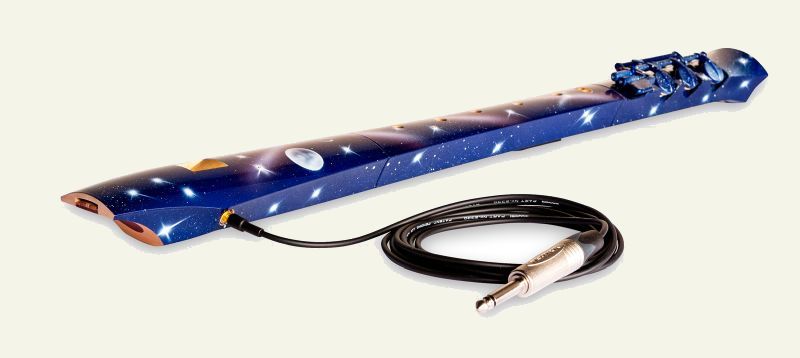
Steve Francis (Australia) produces the PiezoBarrel R1, a pickup designed specifically to overcome the low output of the recorder in the lower register compared with the upper register by boosting the bass response. This provides an inexpensive way for those with very modest DIY skills to explore this new and exciting world. With all these, the output can be fed into an effects panel and amplifier to enhance or modify the sound for live or recorded performance.
Similarly, the American Michael Barker, who teaches at the Royal Conservatory in The Hague, has developed a system linking a square Paetzold subbass recorder in F2 to two computer-controlled synthesisers. This system, which Barker terms an Interactive MIDI Performance System, or ‘midified blockflute’, enables him to mix ‘real’ and synthesised sounds as he plays.
Cesar Villavicencio’s e-recorder
The system developed by Barker has been further extended by Peruvian recorder player and teacher Cesar Villavicencio. This new instrument consists of a Paetzold sub-bass recorder with many sensors installed on it:
- mouth pressure sensor, measures the pressure generated by the player’s breath
- HALL-Generators, detects magnetic fields produced by closing and opening the keys
- 6 buttons, mainly for changing or turning on/off effects
- 2 pressure sensors, triggered by the player’s thumb, not only turns on and off but controls the amount of effects
- 1 fader, controls the output volume of the effects
- The Bird Cage, a stand that allows the instrument to move like a “joystick” equipped with a potentiometer activated by the torsion of the contrabass, and an accelerometer ADXL202 sensitive to the speed of the movement and inclination of the instrument. All sensors produce signals which are received by a 32 analog input device called MUX MICROLAB developed and built at the Sonology Department at the Royal Conservatory in The Hague. This device converts the signals to MIDI which is then routed to a Mac PowerBook running a program called MAX-MSP which is responsible for the sound processing.
Robot recorder-players
Towards the end of his life, the Australian/American composer Percy Grainger became interested in electrical and mechanical musical instruments designed for use in the context of his so-called ‘free music’. A number of ‘free music machines’ capable of playing continuous gliding tones were developed with a US collaborator, Burnett Cross, and included both electronic and air-blown instruments. Amongst the latter, a machine from 1950 survives in the Grainger Museum, Melbourne, in which a Swanee whistle and two recorders (alto and tenor given, to Grainger by Arnold Dolmetsch) are operated by a roll of paper perforated with holes and slits cut by hand (Davis 1984).
Free Music Machine incorporating a Swanee whistle & two recorders,
by Percy Grainger & Burnett Cross, Grainer Museum, Melbourne
Perhaps the inevitable outcome of the mechanisation of the recorder commenced by Percy Grainger in the 1950s (see above) is the development of musician robots capable of playing the recorder. This has been achieved in the ground-breaking research of Makoto Kajitani and his colleagues on a MUBOT that comprises a computer-driven mechanism that plays an unmodified recorder (Kajitani 1989, 1992, 1999, Kapur 2005).
In the recorder-playing MUBOT, blowing is generated by converting air supplies from an air compressor at a predetermined pressure into the optimal flow for each tone by a current-to-pneumatic converter. Vibrato is created by delicately changing the value of the flow instruction to the pneumatic converter. Articulation is achieved by opening and closing an air valve at the entrance to the recorder windway. Rubber fingertips are placed over each vent of the recorder and driven by an air cylinder of the pencil type. The octaving vent is so designed that it can be half or fully opened and fully closed. The recorder-playing MUBOT can join with other MUBOT musicians playing violin, cello, and guitar in performing ensembles. All that is wanting is an audience of robotic listeners. What a jolly prospect!
RePRo (Recorder Performance Robot) in action, playing Kimi no Shiranai Monogatari,
see Kato et al. (2011), Masuda et al. (2012)
Electronic wind instruments
Until recently, the only purely electronic ‘recorders’ as such were made by Innovations Fm7 and Suzuki. Fm7’s MIDIWIND MW-1 was described as a recorder paradigm instrument designed specifically for the elementary education market. The controller was sized to work well with both children’s and adult-sized hands. The unit, slaved to a sound module (called the “Player Station”), provided built-in sounds via MIDI output. The Player Station could accept up to four MIDIWIND controllers simultaneously and was designed to be used in a classroom music lab. The Suzuki SRW-100 Recorder Wind Controller was an electronic input device for use with MIDI instruments. It used standard recorder fingerings, was equipped with pressure-sensitive finger holes, and required traditional breath control.
By now, there are several more versatile electronic recorders on the market, most notably the Artinoise re.corder, described by its developer as “the recorder reinvented”, aimed squarely at the educational market but a very impressive and appealing instrument. Another is Cantux Research’s eCorder, built by Michael Shonle and reviewed by Sarah Jeffrey (aka Team Recorder).
Of these two products, it seems to me that the clearly focussed approach taken by the developers of the re.corder is on firmer ground than that of the eCorder. The former is further along the development path and have a far better handle on marketing and advertising. But it is early days yet and the progress of instruments like the re.corder and eCorder will be very interesting to watch.
Electronic Wind Instruments (EWIs) have a long history of development, manufacture, marketing, and use in the music industry. They are all breath-controlled and variously equipped with pressure-sensitive finger holes, keys, or pads. They can be programmed to produce the sound of almost any instrument, including the recorder. They are capable of glissando, portamento, chords, “timbre attack” (a type of chorusing), and other effects. Some can be programmed to play with the fingerings of a variety of acoustic instruments. Most EWIs are designed to be used with a synthesizer.
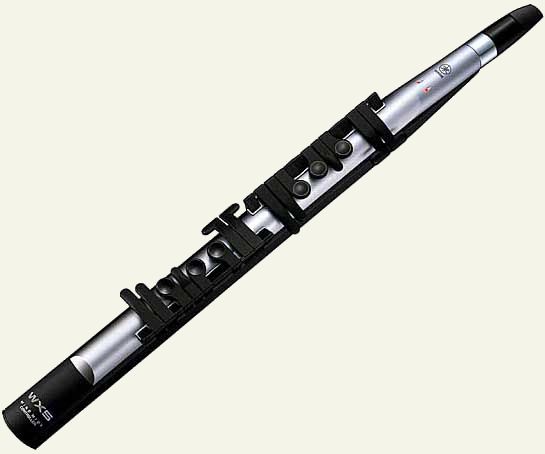

References cited on this page
- Bolton, Philippe. 2025. “The Flageolet, a Forgotten Instrument.” Recorder Magazine 45 (1): 11–17.
- Boragno, Pierre. 1998. “Flûtes du moyen age: éléments de recherche” [Members of the Flute Family of the Middle Ages: Elements of Research].” Les cahiers de musique médiévale 2: 6–20.
- Bowman, Peter. 2014. “Microtonality and the Recorder 1961-2013.” Canterbury: Christ Church University.
- Burger, Hans-Joachim, and Nik Tarasov. 2001. “Synpor – oder die Kunst des Erfindens” [Synpor – or the Art of Invention]. Windkanal, no. 2: 14–18.
- Burgess, Geoffrey. 2015. Well-Tempered Woodwinds: Friedrich von Huene and the Making of Early Music in a New World. Bloomington & Indianapolis: University Press.
- Cave, Charles John P. 1953. Medieval Carvings in Exeter Cathedral, with a Note on the Art of the Exeter Carvers by Nikolaus Pevsner. King Penguin Books 62. London: Penguin.
- (Cave, Penelope. 2003. “Michael Heale: Memories of the First Indentured Apprentice at Arnold Dolmetsch Ltd.” The Consort 59: 889–95.
- Crispin, B. 1968. “In the Minstrel’s Gallery.” Recorder & Music 2 (11): 358–59.
- Davis, Hugh. 1984. “Cross-Grainger Free Music Machine.” In The New GROVE Dictionary of Musical Instruments, edited by Stanley J. Sadie, 1, A to F:517–18. London: Macmillan.
- Delong, Anne. 2015. “Make Your Own Recorder Mute – and Recycle Too!” Accessed September 26.
- Dessy, Raymond, and Lee Dessy. 2001. “Sound-off: Recorder Mikes: What Sounds Good, Is Good!”
- Diderot, Dennis, and Jean le Rond d’Alembert. 1751. Encyclopédie, ou dictionnaire raisonné des sciences, des arts et des métiers … [Encyclopedia or Analytical Dictionary of the Sciences, Arts, and Trades]. 17 vols. Paris (vols 1-7) & Neufchâtel ( vols. 8-17): Briasson & Faulche.
- Dolmetsch, Carl F. 1974. The School Recorder Book. Revised Edition. 3. Leeds: E.J. Arnold & Son.
- Dolmetsch, Carl F. 1996. “The Recorder in Evolution.” Recorder Magazine 16 (2): 56–57.
- Epstein, Jan. 1988. “An Interview with Frans Brüggen.” Recorder: Journal of the Victorian Recorder Guild 8: 8–10.
- Fajardo, Raoul J. 1970. “Enhancing the Recorder Sound.” Recorder and Music Magazine 3 (5): 172–74.
- Fröhlich, Susanne. 2019. “The New Potential of a 21st Century Recorder.” Dissertation, Graz: Universität für Musik und darstellende Kunst.
- Henseler, Ewald, and M. Otse. 2010. “How the Recorder Came to Japan.” American Recorder 51 (1): 9–22.
- Hopkin, Bart. 2021. The ‘Moe family of wind instruments. https://www.youtube.com/watch?v=bsiKxaxiqcw
- Hopkin, Bart. 2024. ‘Moe Flute. https://barthopkin.com/instrumentarium/moe-flute/
- Huene, Friedrich von. 1994. “Efforts to Modernize the Recorder.” Recorder Magazine 15 (4): 135–37.
- Hulthèn, A.L. 1997. “Ragnar blandar tekniken med musiken = Ragnar Blends Technology with Music.” Kontakt
- Hunt, Edgar H. 1961. “Recorder Fingerings.” Galpin Society Journal 14: 75–76.
- Jerome, Ted. 2002. “Orkon.” Last accessed September 2016.
- Kapur, Ajay. 2005. “A History of Robotic Musical Instruments.” In Proceedings, International Computer Music Conference. Barcelona.
- Kajitani, Makoto. 1989. “Development of Musician Robots.” Journal of Robotics and Mechatronics 1: 254–55.
- Kajitani, Makoto. 1999. “Development of Musican Robots in Japan.”
- Kajitani, Makoto. 1992. “Simulation of Musical Performances.” Journal of Robotics and Mechatronics 4 (6): 462–65.
- Kato, Tomonori, Yoshiyuki Kawamura, Kenji Kawashima, and Toshiharu Kangawa. 2011. “Control of Blown Air for a Soprano-Recorder-Playing Robot Using Unsteady Flow Rate Measurements and Control Techniques.” In Proceedings of the 8th JFPS International Symposium on Fluid Power, 626–32. Okinawa: Journal of the Fluid Power Society.
- Kinsky, George, Robert Haas, and Hans Schnoor. 1930. A History of Music in Pictures. London: J. Dent & Sons.
- Lander, Nicholas S. 1996–2025. Recorder Home Page: Leonardo da Vinci’s Recorders. Last accessed 9 April 2025. https://recorderhomepage.net/leonardo-da-vincis-recorders/
- Lasocki, David R.G. 2005. “A Listing of Inventories and Purchases of Flutes, Recorders, Flageolets, and Tabor Pipes, 1388-1630.” In Musique de Joye: Proceedings of the International Symposium on the Renassiance Flute and Recorder Consort. Utrecht 2003, 419–511. Utrecht: STIMU Stichting Muziekhistorische Uitvoeringspraktijk (Foundation for Historical Performance Practice).
- Loretto, Alec V. 1970. “Adjustable Lip on the Recorder.” Recorder and Music Magazine 3 (8): 278–79.
- Loretto, Alec V. 1993. “Plastic Recorders.” Recorder Magazine 13 (1): 3–4.
- Loretto, Alec V. 1998. “Letters to the Editor: Bell Keys.” Recorder Magazine 18 (4): 156–57.
- Madgwick, Paul, and Alec V. Loretto. 1996. Communication 1486: “Old Recorders for New (Recorder Patents).” FoMRHI Quarterly 85: 35–44.
- Masuda, Hiromo, Tomonori Kato, and Toshiharu Kagawa. 2012. “Development of a Recorder-Playing Robot Using Unsteady Flow Rate Control Technique.” In Proceedings of SICE Annual Conference, 1319–24. Gakujutsu Kōenkai: Society of Instrumentation and Control Engineers.
- Mersenne, Marin. 1636. Harmonie universelle, contenant la théorie et la pratique de la musique, où il est traité de la nature des sons, et des mouvemens, des consonances, des dissonances, des generes, des modes, de la composition, de la voix, des chants, et de toutes sortes d’instruments harmoniques. [Universal harmony, containing the theory and practice of music, in which is treated the nature of sounds as well as tempos, consonances, dissonances, genres, modes, composition, the voice, songs, and all kinds of musical instruments]. Paris: Sébastien Cramoisy.
- Moeck, Hermann A. 1997. “Blockflötenmundstück mit Frequenzregler” [Recorder Windways with Turbulence Regulators]. Tibia 22 (3): 525.
- Reinhardt, Bruno. 1984. “La flûte à bec: des clés pour le futur! [The Recorder, Keys for the Future].” Flûte à bec & instruments anciens 15: 2–3.
- Schmidt, Lloyd J. 1959. “A Practical and Historical Source-Book for the Recorder.” Ph.D dissertation, Evanston: Northwestern University. Oak Grove Library Center.
- Schellenberger, Christoff. 1955. “Vielerlei Flöten und Pfeifen [Various flutes and pipes].” Werkbogen J4 der Werkgemeinde [Worksheet J4 of the Work Community], Bärenreiter-Verlag, Kassel. VIAF ID 49740758. Deutsch National Bibliothek.
- Schumann, Heinrich. 1952. Die Bambusflöte. Anleitung zur Herstellung verschiedener Flötentypen [The Bamboo Flute. Instructions for Making Different Types of Flute]. In Musikerziehung und Musikpflege [Building Blocks for Music Education and Music Care], ed. Fritz Jöde, Vol. 7. Mainz: Schott’s Söhne.
- Sela, Bárbara, and Guido Peñalver. 1996. “Fabricantes de flautas de pico en el siglo XX.” Revista de flauta de pico.
- Stephenson, N. 1987. “Memo from Wales: Lecturers Hit the Right Note with Spit-Free Recorder.” The Recorder: Australia’s Journal of Recorder & Early Music 6: 34.
- Tarasov, Nik. 2005. “Historischer Blockflötenbau: Bahn frei! Kreative Blocckonstruktionen in 19 Jahrhundert” [Historical Recorder Making: Make way! Creative Block Construction in the 19th Century]. Windkanal, no. 4: 14–17.
- Thalheimer, Peter. 2013. Vergessen und wiederentdeckt : die Blockflöte: 200 Instrumente der Jahre 1926 bis 1945 aus vogtländischen Werkstätten = Forgotten and Rediscovered : The Recorder : 200 Instruments Made in the Vogtland Region Between 1926 and 1945. Vol. 3. Meisterleistungen deutscher Instrumentenbaukunst = Masterpieces of German Instrument Making. Markneukirchen: Verein der Freunde und Förderer des Musikinstrumenten-Museums Markneukirchen e. V.
- Thalheimer, Peter. 2021. “„Pipers’ Music“ und „Pipeaux Mélodies“ Bambusflötenmusik im Blockflötenrepertoire [“‘Pipers’ Music’ and ‘Pipeaux Mélodies’, Bamboo flute music in the recorder repertoire”]. Tibia – Online. 2021.
- Thomas, Denis. 2004. “A Novel Compact F Contra[bass].” Recorder and Music 24 (4): 120–22.
- Thomas, Denis. 1998. “‘Letters to the Editor: Bell Key Patent.” Recorder Magazine 18 (2): 73.
- Tsukumoto, Takashi. 1975. “Another Bell Key.” Recorder and Music Magazine 5 (2): 45–57.
- Tucker, Tui St George (undated). Alto recorder fingering chart showing microtones.
- Váczi, Dániel & Tóbiás Terebessy 2024. Glissonic Instruments. Budapest. https://glissonic.com
- Waitzman, Daniel. 1978. The Art of Playing the Recorder. New York: AMS Press.
- Waitzman, Daniel. 1968. “The Bell Key.” Recorder and Music Magazine 2 (10): 324–27.
- Waitzman, Daniel. 1969. “Bell-Key Probe.” Recorder and Music Magazine 3 (3): 86.
- Ward, C. Leslie C. 1949. The Dolmetsch Workshops. Revised 1954-1961. Haslemere: Arnold Dolmetsch Ltd.
Cite this article as: Lander, Nicholas S. 1996–2025. Recorder Home Page: History: Innovations. Last accessed 13 July 2025. https://recorderhomepage.net/history/innovations-in-recorder-design/
